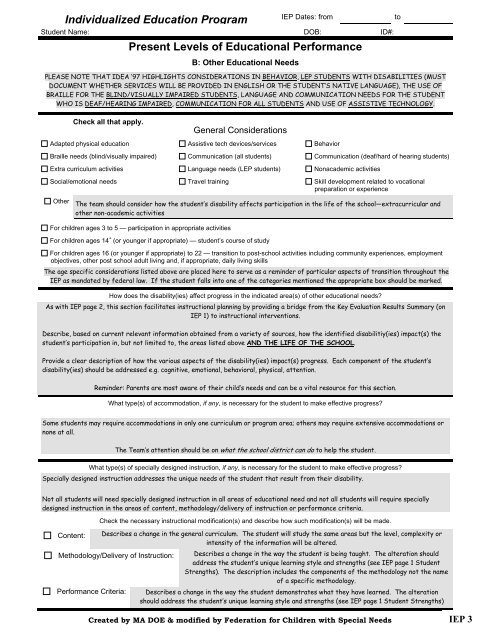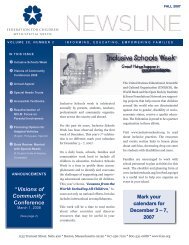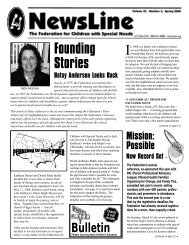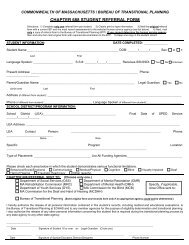IEP Writing Guide - Federation for Children with Special Needs
IEP Writing Guide - Federation for Children with Special Needs
IEP Writing Guide - Federation for Children with Special Needs
You also want an ePaper? Increase the reach of your titles
YUMPU automatically turns print PDFs into web optimized ePapers that Google loves.
Individualized Education Program<br />
<strong>IEP</strong> Dates: from to<br />
Student Name: DOB: ID#:<br />
Present Levels of Educational Per<strong>for</strong>mance<br />
B: Other Educational <strong>Needs</strong><br />
PLEASE NOTE THAT IDEA ’97 HIGHLIGHTS CONSIDERATIONS IN BEHAVIOR, LEP STUDENTS WITH DISABILITIES (MUST<br />
DOCUMENT WHETHER SERVICES WILL BE PROVIDED IN ENGLISH OR THE STUDENT’S NATIVE LANGUAGE), THE USE OF<br />
BRAILLE FOR THE BLIND/VISUALLY IMPAIRED STUDENTS, LANGUAGE AND COMMUNICATION NEEDS FOR THE STUDENT<br />
WHO IS DEAF/HEARING IMPAIRED, COMMUNICATION FOR ALL STUDENTS AND USE OF ASSISTIVE TECHNOLOGY.<br />
Check all that apply.<br />
General Considerations<br />
Adapted physical education Assistive tech devices/services Behavior<br />
Braille needs (blind/visually impaired) Communication (all students) Communication (deaf/hard of hearing students)<br />
Extra curriculum activities Language needs (LEP students) Nonacademic activities<br />
Social/emotional needs Travel training Skill development related to vocational<br />
preparation or experience<br />
Other<br />
The team should consider how the student’s disability affects participation in the life of the school—extracurricular and<br />
other non-academic activities<br />
For children ages 3 to 5 — participation in appropriate activities<br />
For children ages 14 + (or younger if appropriate) — student’s course of study<br />
For children ages 16 (or younger if appropriate) to 22 — transition to post-school activities including community experiences, employment<br />
objectives, other post school adult living and, if appropriate, daily living skills<br />
The age specific considerations listed above are placed here to serve as a reminder of particular aspects of transition throughout the<br />
<strong>IEP</strong> as mandated by federal law. If the student falls into one of the categories mentioned the appropriate box should be marked.<br />
How does the disability(ies) affect progress in the indicated area(s) of other educational needs?<br />
As <strong>with</strong> <strong>IEP</strong> page 2, this section facilitates instructional planning by providing a bridge from the Key Evaluation Results Summary (on<br />
<strong>IEP</strong> 1) to instructional interventions.<br />
Describe, based on current relevant in<strong>for</strong>mation obtained from a variety of sources, how the identified disabilitiy(ies) impact(s) the<br />
student’s participation in, but not limited to, the areas listed above AND THE LIFE OF THE SCHOOL.<br />
Provide a clear description of how the various aspects of the disability(ies) impact(s) progress. Each component of the student’s<br />
disability(ies) should be addressed e.g. cognitive, emotional, behavioral, physical, attention.<br />
Reminder: Parents are most aware of their child’s needs and can be a vital resource <strong>for</strong> this section.<br />
What type(s) of accommodation, if any, is necessary <strong>for</strong> the student to make effective progress?<br />
Some students may require accommodations in only one curriculum or program area; others may require extensive accommodations or<br />
none at all.<br />
The Team’s attention should be on what the school district can do to help the student.<br />
What type(s) of specially designed instruction, if any, is necessary <strong>for</strong> the student to make effective progress?<br />
<strong>Special</strong>ly designed instruction addresses the unique needs of the student that result from their disability.<br />
Not all students will need specially designed instruction in all areas of educational need and not all students will require specially<br />
designed instruction in the areas of content, methodology/delivery of instruction or per<strong>for</strong>mance criteria.<br />
Content:<br />
Check the necessary instructional modification(s) and describe how such modification(s) will be made.<br />
Describes a change in the general curriculum. The student will study the same areas but the level, complexity or<br />
intensity of the in<strong>for</strong>mation will be altered.<br />
Methodology/Delivery of Instruction:<br />
Per<strong>for</strong>mance Criteria:<br />
Describes a change in the way the student is being taught. The alteration should<br />
address the student’s unique learning style and strengths (see <strong>IEP</strong> page 1 Student<br />
Strengths). The description includes the components of the methodology not the name<br />
of a specific methodology.<br />
Describes a change in the way the student demonstrates what they have learned. The alteration<br />
should address the student’s unique learning style and strengths (see <strong>IEP</strong> page 1 Student Strengths)<br />
Created by MA DOE & modified by <strong>Federation</strong> <strong>for</strong> <strong>Children</strong> <strong>with</strong> <strong>Special</strong> <strong>Needs</strong><br />
<strong>IEP</strong> 3









